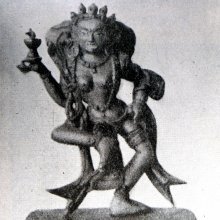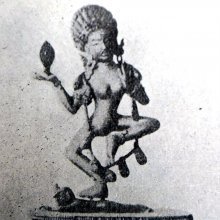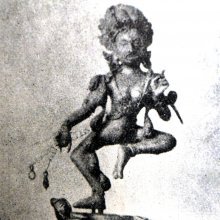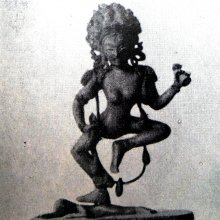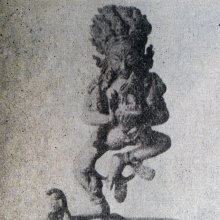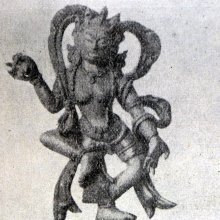Violent: 1 definition
Introduction:
Violent means something in Hinduism, Sanskrit. If you want to know the exact meaning, history, etymology or English translation of this term then check out the descriptions on this page. Add your comment or reference to a book if you want to contribute to this summary article.
Images (photo gallery)
(+9 more images available)
In Hinduism
Shilpashastra (iconography)
Source: Shodhganga: Elements of Art and Architecture in the Trtiyakhanda of the Visnudharmottarapurana (shilpa)Violent activities are associated withe the Terrible Sentiment (bhayānaka), which refers to one of the Nine Sentiments (citrarasa) in ancient Indian Painting (citra), according to the Viṣṇudharmottarapurāṇa, an ancient Sanskrit text which (being encyclopedic in nature) deals with a variety of cultural topics such as arts, architecture, music, grammar and astronomy.—According to the Viṣṇudharmottarapurāṇa, bhayānakarasa can be manifested in a Painting through the portrayal of wicked or terrible looking persons engaged in crazy and violent activities. [...] Thus, painting is a medium of showing the inner feelings and emotions of a painter which can strikes the inherent sentiments of connoisseur’s mind, for example: violent activities in the terrible sentiment.

Shilpashastra (शिल्पशास्त्र, śilpaśāstra) represents the ancient Indian science (shastra) of creative arts (shilpa) such as sculpture, iconography and painting. Closely related to Vastushastra (architecture), they often share the same literature.
See also (Relevant definitions)
Starts with: Violent mood.
Query error!
Full-text (+1296): Atidaha, Prakopa, Sahasika, Prakampa, Attahasa, Sahasin, Canda, Pracanda, Prabala, Roruda, Tandava, Pratirambha, Durmarana, Prakampana, Vatahati, Uttala, Tivra, Marda, Apaghata, Ghora.
Relevant text
Search found 284 books and stories containing Violent; (plurals include: Violents). You can also click to the full overview containing English textual excerpts. Below are direct links for the most relevant articles:
Archives of Social Sciences of Religions
Sufism and Politics: The Khwajas-Naqshbandis of Eastern Turkestan < [Volume 136 (2006)]
Extreme Thinking: How Ordinary People Become Fanatics < [Volume 156 (2011)]
Possession and Shamanism: Masters of Disorder < [Volume 112 (2000)]
The Cult of Non-Violence < [October 1969]
The House < [July – September, 1995]
Non-Violence Through The Ages < [January 1959]
Yavanajataka by Sphujidhvaja [Sanskrit/English] (by Michael D Neely)
Verse 3.10 < [Chapter 3 - One’s Own Form of the Drekkāṇas]
Verse 73.16 < [Chapter 73 - Result of the Nakṣatras and Tithis on Military Expeditions]
Verse 3.36 < [Chapter 3 - One’s Own Form of the Drekkāṇas]
Dasarupaka (critical study) (by Anuru Ranjan Mishra)
Part 8 - Styles (vṛtti) of the Ḍima < [Chapter 4 - Ḍima (critical study)]
Part 8 - Styles (vṛtti) of the Prakaraṇa < [Chapter 10 - Prakaraṇa (critical study)]
Part 3-6 - Ḍima rules < [Chapter 4 - Ḍima (critical study)]
Bhagavati-sutra (Viyaha-pannatti) (by K. C. Lalwani)
Part 6 - Bondage due to the formation of a kārmaṇ body < [Chapter 9]
Part 5 - On heretical tenets < [Chapter 6]
Part 1 - On short and long spans of life < [Chapter 6]
Related products
